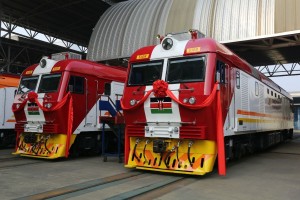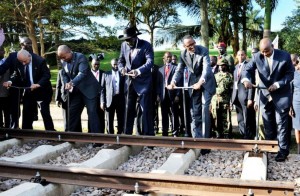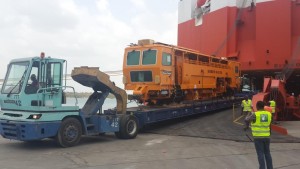Shifting cargo to trains will decide SGR value

The Chinese made locomotives will be able to haul half of the cargo presently being ferried between Nairobi and Mombasa by trucks.
April 13–Repeated queries in Uganda surrounding the costs of a new $3.2 billion Standard Gauge Railway (SGR) brings to mind a largely ignored 2013 briefing note prepared by the World Bank Africa Transport Unit that said building a new railway makes no economic sense.
Not a popular view at the time and understandable why the document did not get much airing in public around the region. East African leaders see a new SGR network as a game-changer for making the region far more competitive as an investment destination.
But authors said investment in SGR appears only to be justified if it could attract additional freight in the order of 20-55 million tons per year across East Africa. At the moment trucks dominate the regional transit cargo business.
Below are highlights of the briefing note as Kenya prepares to begin commercial operations of the Mombasa-Nairobi SGR leg in June. Top officials at the Kenya Railways (KRC) say when the SGR is open, freight trains will carry 25 million tons annually at 120 kilometres per hour (kph). The briefing note was published before the Kenya government contracted the Chinese to start building the SGR.
The note lays out four main alternatives to upgrade the railway network in the East African Community (EAC) countries.
(1) rehabilitate the existing network to the original standard and gauge,
(2) refurbish/upgrade the network ·to a higher standard, with the same gauge;
(3) refurbish/upgrade the network to a higher standard, with a different gauge such as SGR on the same alignment, or (4) construct a new right-of-way.
Rehabilitating the existing railway network would allow a phased approach to its development, consistent with current and projected demand and the financing envelope available. This would involve necessary investment to achieve reliability and good average operating speeds, with a focus on those sections needing most remediation. This represents the most cost-effective option for the development of the railway infrastructure.
Refurbishing or Upgrading the railway network to the same gauge, would imply a far more substantial intervention, raising the quality and operating speeds along much of the network, where justified by current and projected traffic. This solution is more expensive upfront, as greater investment is required, but also relatively cost-effective since it allows for re-use of materials and existing right-of-way. In addition, the characteristics of the refurbished infrastructure can be equivalent to or surpass the design standard of the existing infrastructure.

East African leaders see a new SGR network as a game-changer in making the region more competitive as an investment destination.
Upgrading a Metre gauge (current line) to Standard gauge essentially involves the construction of a new railway, broadly along the same alignment. This solution is more expensive upfront, as greater investment is required, but there are cost savings compared to the construction of a SGR on a completely new alignment, through reduction in the amount of new land required, and possibly the scale of some structures.
Finally, alternative four involves the construction of a SGR on a new right-of-way. This option requires additional investment in land acquisition and structures, together with new right-of-way construction.
When it comes to benefits and costs, it is assumed under the first alternative that axle loads in the order of 15-18 tons per axles would be realized for the poorest part of the infrastructure, and maximum operating speeds of up to 80kph.
Based on these assumptions, the estimated maximum carrying capacity of the network would be around 5.5 million tons per year. The estimated investment cost per km of track to implement this alternative is in the order of $0.18 million ($180,000).
Alternative 2 predicates axle loads in the order of 25 tons per axles and a maximum operating speed of up to 120kph. Based on these assumptions, the estimated maximum carrying capacity of the network would be around 60 million tons per year. The estimated investment cost per km of track to implement this alternative is in the order of $0.49 million ($490,000).
Alternative 3 predicates axle loads in the order of 25 tons per axles and a maximum operating speed of up to 130 kph. Based on these assumptions, the estimated maximum carrying capacity of the network would exceed 60 million tons per year. The estimated investment cost per km of track to implement this alternative is in the order of $1.5 million.
Alternative 4 also predicates axle loads in the order of 25 tons per axles and a maximum operating speed of up to 120 kph. Again, based on these assumptions, the estimated maximum carrying capacity of the current network would exceed 60 million tons per year. The estimated investment cost per km of track to implement this alternative is in the order of $3.25 million. All cost estimates exclude additional investment necessary to procure the required locomotives and rolling stock for the projected traffic on the network.
The Expected Benefits
According to the briefing note, the current freight volume carried in the EAC railway network was 1.6 million tons in 2009, resulting in estimated revenue of $65 million. One estimate is that freight traffic on the entire EAC rail network will grow to approximately 14.4 million tons per year by 2030. This, based on the same assumptions, would represent annual revenues in the order of $585 million per year. Using this information, each alternative can be evaluated as follows:
Alternative 1: This alternative requires the lowest investment requirements. Without the upgrading of some sections, the maximum amount of traffic that could be accommodated would be 5.5 million tons per year. So based on the traffic projections in the EAC Railway Masterplan, capacity constraints are likely to emerge on the network well before 2030.
Alternative 2: Would involve higher investment requirements, as above, but would ensure no capacity constraint on the EAC railway network by the end of the forecasting period, 2030. The additional investment required for this alternative as compared with the first would be justified if an additional 6.2 million tons per year of freight traffic could be attracted to the network.
Alternative 3: This alternative will also ensure that no capacity constraints emerge before the end of the forecasting period 2030. However, since the investment cost per km of track is $1.5 million compared to $490,000 for Alternative 2, the conversion to SGR on the same right-of-way is only justified if an additional 20.2 million tons per year of freight traffic could be attracted to the network.
Alternative 4: It can also accommodate the expected traffic. However, the investment cost is considerably higher ($3.25 million per km of track). Consequently, the construction of a SGR line in a new right-of-way is only justified if additional traffic attracted to the line amounted to 55.2 million tons per year.
In conclusion, the briefing note states there is no economic or financial case for SGR in the EAC area at this time. Alternative two involving a refurbished Metre gauge network would appear to be the most appropriate option in economic and financial terms and could easily accommodate forecast traffic up to 2030, with lower investment requirements.
Investment in SGR appears only to be justified if the new infrastructure could attract additional freight in the order of 20-55 million tons per year. Based on the traffic forecasts undertaken for the EAC Railway Masterplan and more recent work undertaken on the central line in Tanzania, these volumes would appear to be unattainable over the medium to longer term.

Qalaa Holdings, the majority shareholders in RVR, raised close to $300 million to rehabilitate the Metre line and buy equipment, but only managed to get 5% of the freight business.
It was a pity that the first group of people who successfully tendered to take up the 25 year concession to run the joint Kenya/Uganda railways twisted themselves into all sorts of knots.
Not only did they have difficulties in raising the promised financing, but in the interlude quickly killed off all the goodwill the two governments formerly had for the venture.
By the time Egypt’s Qalaa Holdings (formerly Citadel Capital) bought a majority stake in Rift Valley Railways (RVR) the situation was enough to encourage talk about a totally new way. This however did not stop Qalaa from investing nearly $300 million in patching up and repairing the line as best as it could, but customers declined to shift cargo from road to rail leaving RVR only 5% of the traffic. Now Qalaa want to sell out and are looking for a buyer for their stake.
However, enthusiastic supporters of the SGR say the future is bright for rail freight. According to Kenya Railways Corporation (KRC) just one of the new locomotives will pull 200 containers between Mombasa and the Embakasi Inland Container Depot (ICD) in Nairobi.
KRC plans are for four trains to haul containers daily, making the trip between the port and Nairobi in eight hours. Two passenger trains will move an estimated 1,000 people a day in just four and half hours. SGR trains will ferry between 40% and 50% of port-bound cargo, reducing road damage and general pollution levels.
It has even been suggested that trucking firms would have to move to Nairobi, because business for them in Mombasa will be gone. Gone to SGR.

 African Heads of state head to South Korea next week for Summit talks
African Heads of state head to South Korea next week for Summit talks
 Trading leads as main source of income for Ugandans
Trading leads as main source of income for Ugandans
 New leadership for bankers’ umbrella as total assets top $12 billion
New leadership for bankers’ umbrella as total assets top $12 billion
 Brussels Airlines to announce Nairobi service
Brussels Airlines to announce Nairobi service
 SITA promises enhanced travel experience after Materna acquisition
SITA promises enhanced travel experience after Materna acquisition
 Saudia’s 105 aircraft order stretches A320neo lead over rival Max
Saudia’s 105 aircraft order stretches A320neo lead over rival Max
